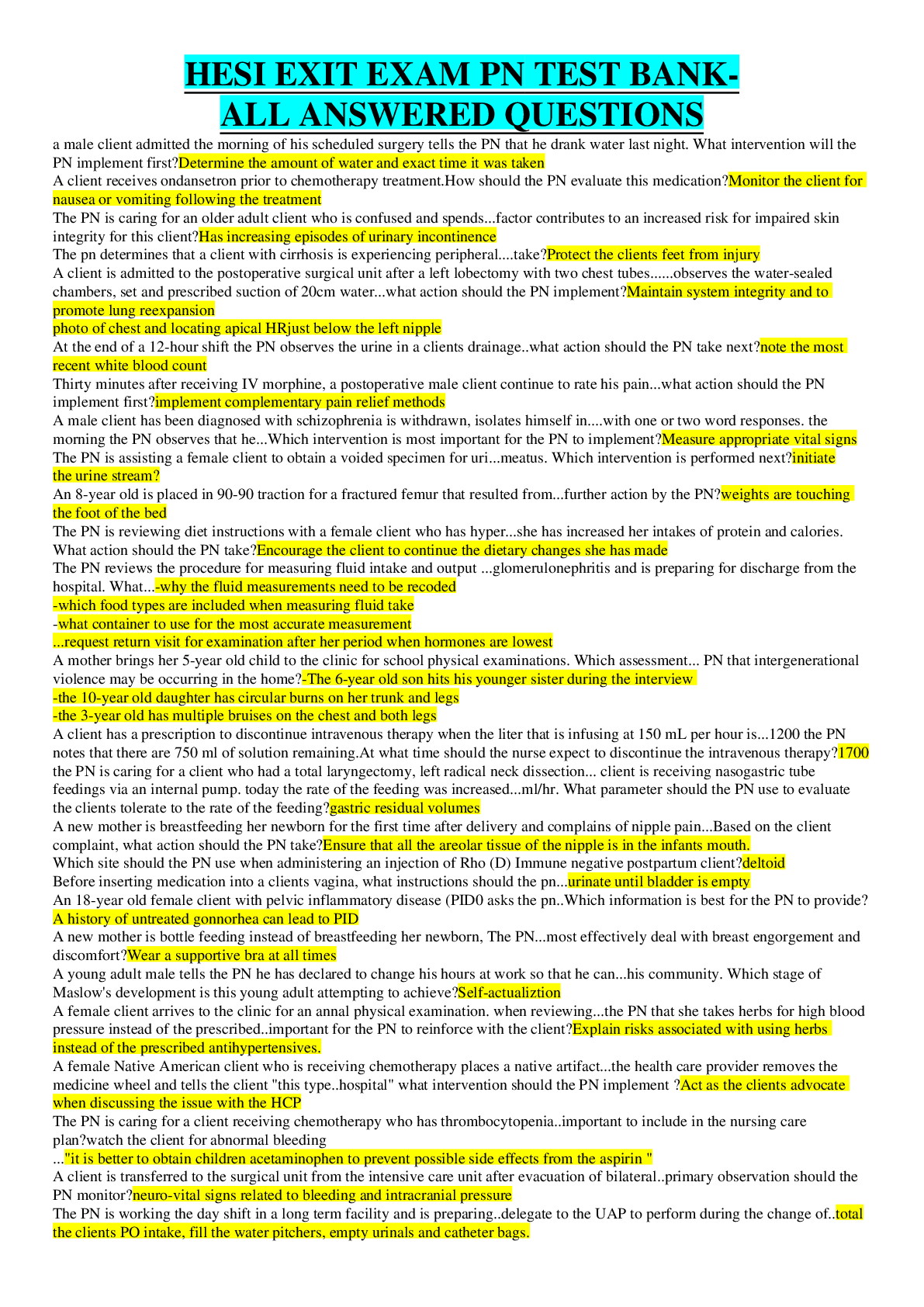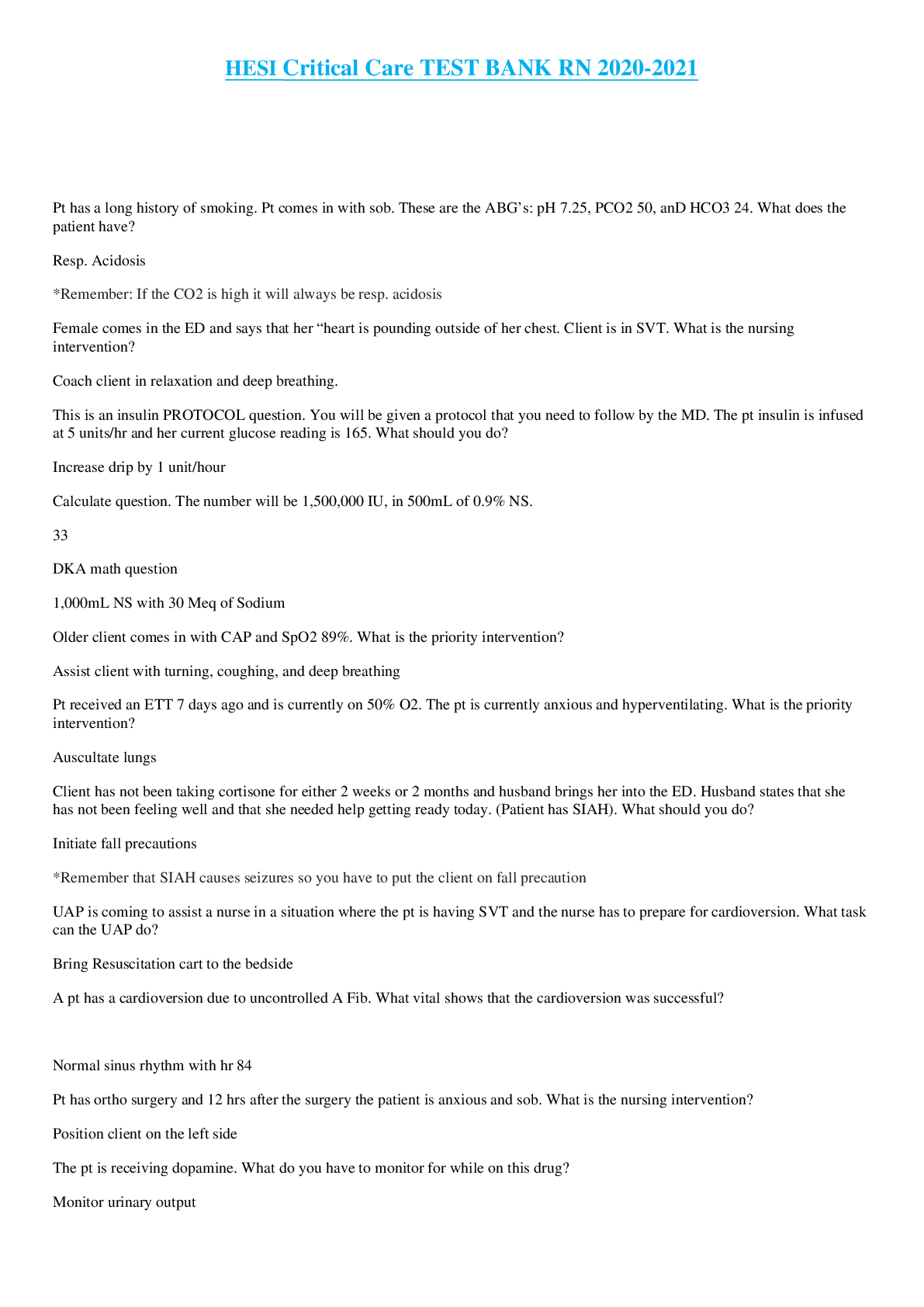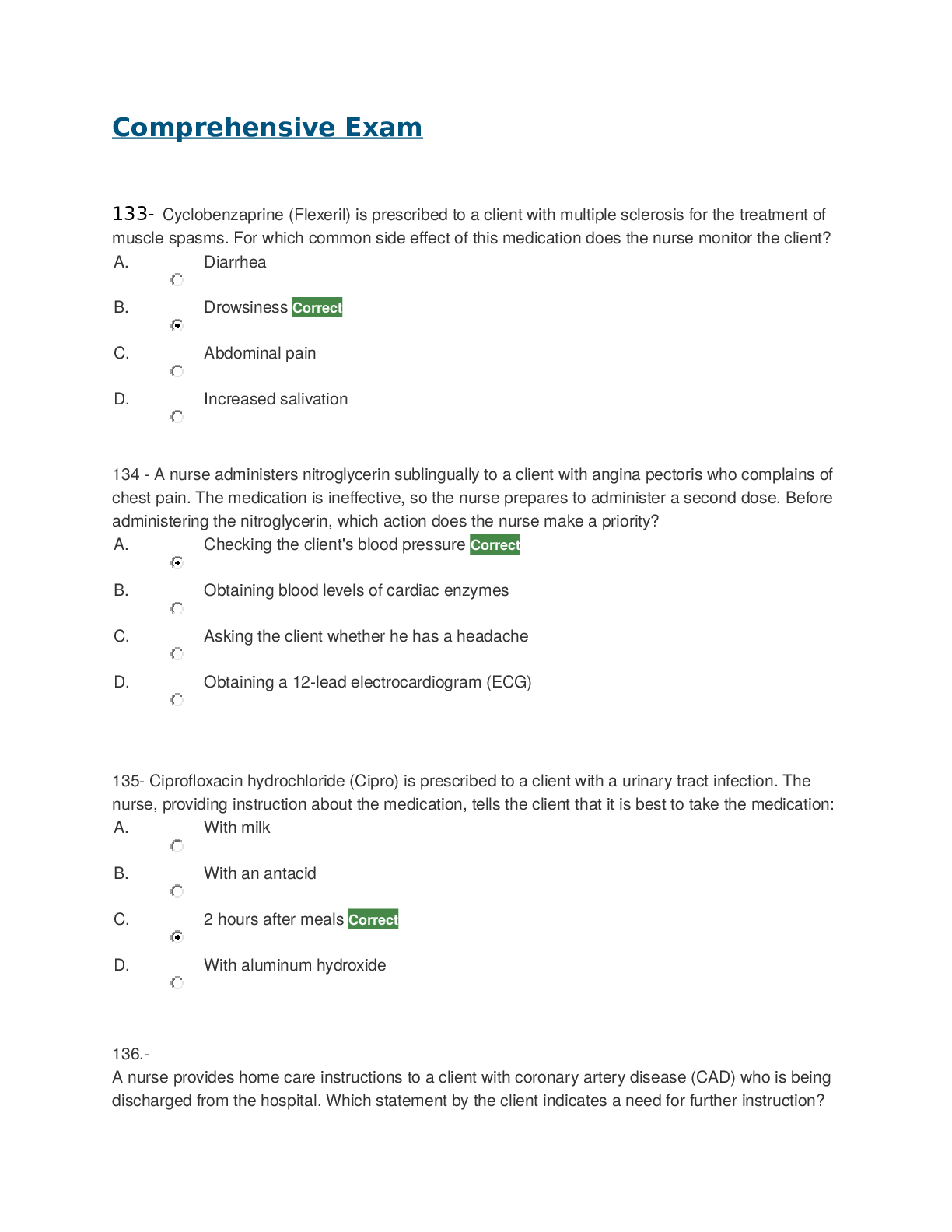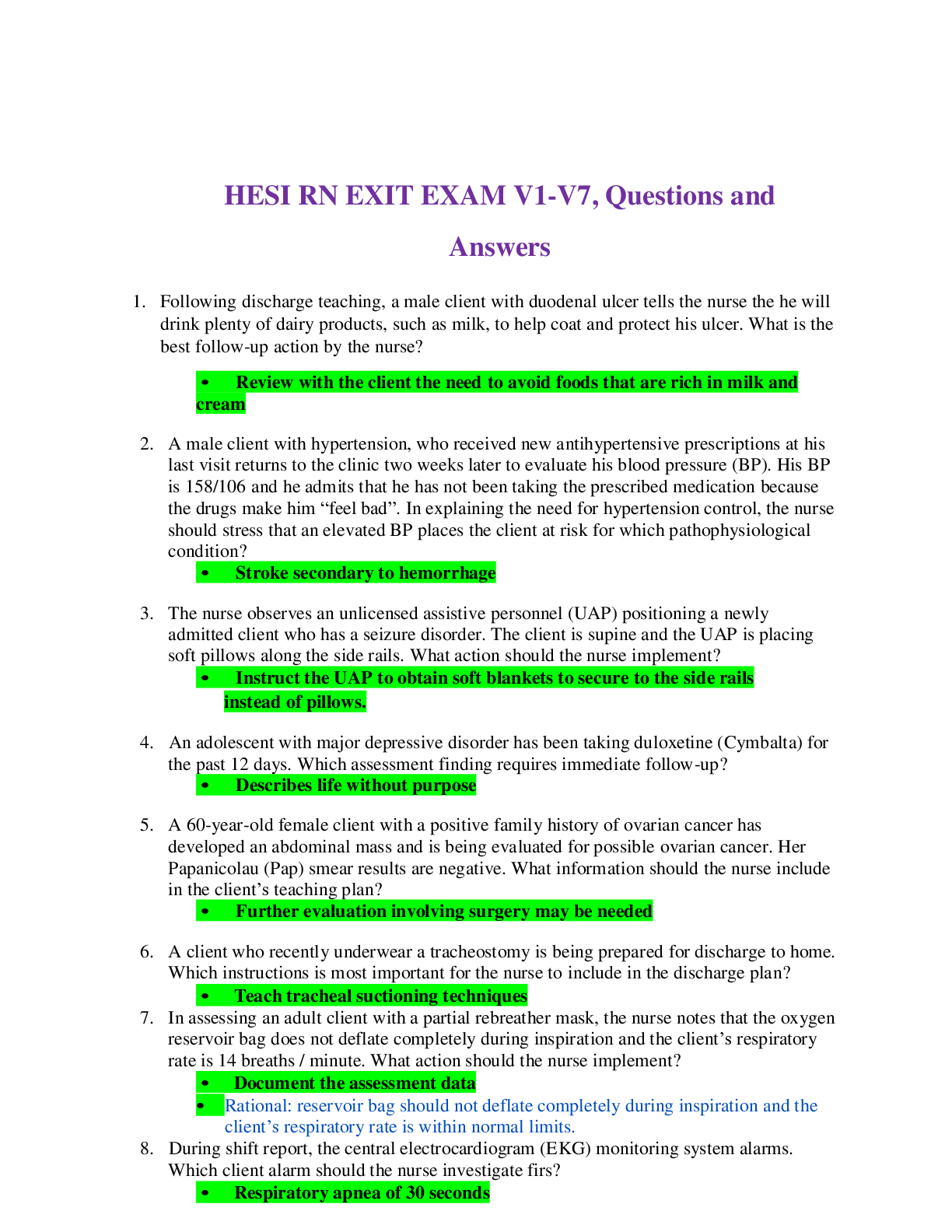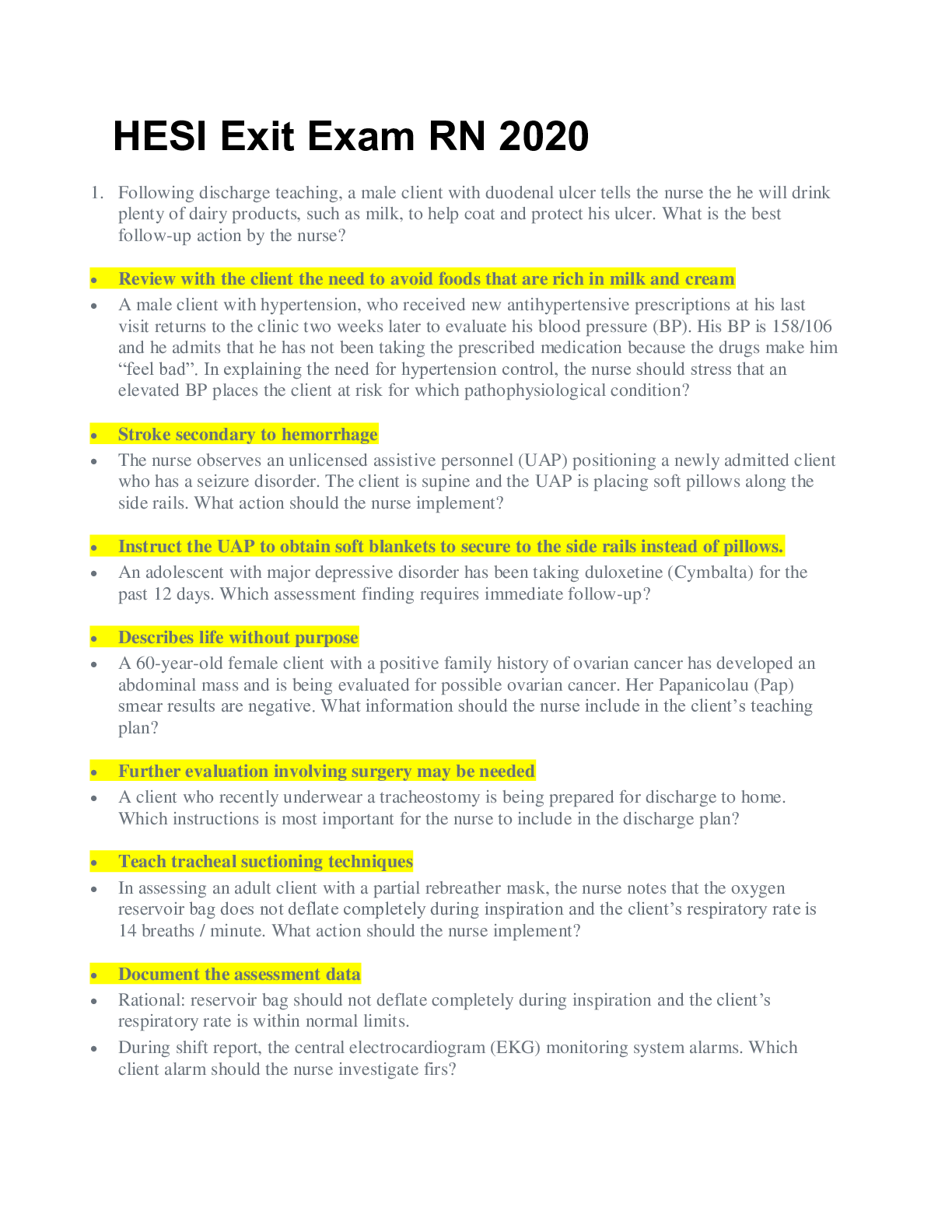Hesi Study Module 10 Physiological Health Problems, Answers & Rationale
Document Content and Description Below
Questions 1.ID: 383719769 A nurse is assigned to care for four clients on the medical-surgical unit. Which client should the nurse see first on the shift assessment? A client admitted with pneumon... ia with a fever of 100° F and some diaphoresis Incorrect A client with congestive heart failure with clear lung sounds on the previous shift A client with new-onset of shortness of breath (SOB) and a history of pulmonary edema Correct A client undergoing long-term corticosteroid therapy with mild bruising on the anterior surfaces of the arms Rationale: The client who should be seen first is the one with SOB and a history of pulmonary edema. In light of such a history, SOB could indicate that fluid-volume overload has once again developed. The client with a fever and who is diaphoretic is at risk for insufficient fluid volume as a result of loss of fluid through the skin, but this client is not the priority. Test-Taking Strategy: Use the process of elimination and focus on the subject of the question, the client who should be seen first. Recall the rule of assessment of the ABCs — airway, breathing, and circulation — which means that the client experiencing SOB should take precedence over the other clients on the unit. This client’s condition could progress to respiratory arrest if the client were not assessed immediately on the basis of the signs and symptoms. Read each option and think about the client in most critical condition and review the disorders to determine which clients have the most critical needs. If you had difficulty with this question, review the various disease processes presented in this question. Reference: Ignatavicius, D., & Workman, M. (2010). Medical-surgical nursing: Patient-centered collaborative care. (6th ed., p. 176). St. Louis: Saunders. Level of Cognitive Ability: Analyzing SendClient Needs: Physiological Integrity Integrated Process: Nursing Process/Assessment Content Area: Delegating/Prioritizing Awarded 0.0 points out of 1.0 possible points. 2.ID: 383719781 A client with gastroenteritis who has been vomiting and has diarrhea is admitted to the hospital with a diagnosis of dehydration. For which clinical manifestations that correlate with this fluid imbalance would the nurse assess the client? Select all that apply. Decreased pulse Decreased urine output Correct Increased blood pressure Increased respiratory rate Correct Decreased respiratory depth Rationale: A client with dehydration has an increased depth and rate of respirations. The diminished fluid volume is perceived by the body as a decreased oxygen level (hypoxia), and increased respiration is an attempt to maintain oxygen delivery. Other assessment findings in insufficient fluid volume are decreased urine volume, increased pulse, weight loss, poor skin turgor, dry mucous membranes, concentrated urine with increased specific gravity, increased hematocrit, and altered level of consciousness. Increased blood pressure, decreased pulse, and increased urine output occur with fluidvolume overload. Test-Taking Strategy: Use the process of elimination and focus on the subject, dehydration (deficient fluid volume). Think about the pathophysiology of deficient fluid volume. Remember that the body will increase the respiratory rate in an attempt to maintain the oxygen level. If you had difficulty with this question, review the signs of insufficient fluid volume.Reference: Ignatavicius, D., & Workman, M. (2010). Medical-surgical nursing: Patient-centered collaborative care (6th ed., p. 179). St. Louis: Saunders. Level of Cognitive Ability: Analyzing Client Needs: Physiological Integrity Integrated Process: Nursing Process/Assessment Content Area: Fluid and Electrolytes Awarded 0.0 points out of 1.0 possible points. 3.ID: 383720547 A nurse is reviewing the medical records of the clients to whom she is assigned on the 7 am–7 pm shift. Which client will the nurse monitor most closely for excessive fluid volume? A 48-year-old client receiving diuretics to treat hypertension A 35-year old client who is vomiting undigested food after eating An 85-year-old client receiving intravenous (IV) therapy at a rate of 100 mL/hr Correct A 65-year-old client with a nasogastric tube attached to low suction following partial gastrectomy Rationale: The older adult client receiving IV therapy at 100 mL/hr is at the greatest risk for excessive fluid volume because of the diminished cardiovascular and renal function that occur with aging. Other causes of excessive fluid volume include renal failure, heart failure, liver disorders, excessive use of hypotonic IV fluids to replace isotonic losses, excessive irrigation of body fluids, and excessive ingestion of table salt. A client who is receiving diuretics, vomiting, or has a nasogastric tube attached to suction is at risk for deficient fluid volume. Test-Taking Strategy: Read the question carefully, noting that it asks for the client at risk for excessive fluid volume. Read each option and think about the fluid imbalance that could occur in each situation; in the case of the incorrect options, it is fluid-volume deficiency; the only option reflecting conditions that could result in an excess is the correct option. If you had difficulty with this question, review the causesof excessive fluid volume. References: Black, J., & Hawks, J. (2009). Medical-surgical nursing: Clinical management for positive outcomes (8th ed., p. 2202). St. Louis: Saunders. Ignatavicius, D., & Workman, M. (2010). Medical-surgical nursing: Patient-centered collaborative care (6th ed., p. 183). St. Louis: Saunders. Level of Cognitive Ability: Analyzing Client Needs: Physiological Integrity Integrated Process: Nursing Process/Assessment Content Area: Fluid and Electrolytes Awarded 0.0 points out of 1.0 possible points. 4.ID: 383721964 A nurse is caring for a client who is being treated for congestive heart failure and has been assigned a nursing diagnosis of excessive fluid volume. Which assessment finding causes the nurse to determine that the client’s condition has improved? Dyspnea 1+ edema in the legs Moist crackles in the lower lobes of the lungs Weight loss of 4 lb in 24 hours Correct Rationale: One sign that excessive fluid volume is resolving is loss of body weight. It is important to recall that 1 L of fluid weighs 1 kg, which equals 2.2 lb (1 liter = 2.2 lb = 1 kg). The other options listed indicate that the client is retaining fluid. Assessment findings associated with excessive fluid volume include cough, dyspnea, rales or crackles, tachypnea, tachycardia, increased blood pressure and bounding pulse, increased central venous pressure, weight gain, edema, neck and hand vein distention, altered level of consciousness, and decreased hematocrit. These symptoms must be reversed if the fluid-volume excess is to be resolved.Test-Taking Strategy: Use the process of elimination and focus on the subject, a sign that the client’s condition is improving. The only such finding is decreasing body weight. If you had difficulty with this question, review the assessment findings noted in excessive fluid volume and the signs that the condition is resolving. Reference: Ignatavicius, D., & Workman, M. (2010). Medical-surgical nursing: Patient-centered collaborative care (6th ed., pp. 182, 183). St. Louis: Saunders. Level of Cognitive Ability: Evaluating Client Needs: Physiological Integrity Integrated Process: Nursing Process/Evaluation Content Area: Fluid and Electrolytes Awarded 0.0 points out of 1.0 possible points. 5.ID: 383719771 A nurse notes that a client has ST-segment depression on the electrocardiogram (ECG) monitor. With which of the following serum potassium readings does the nurse associate this finding? 3.1 mEq/L Correct 4.2 mEq/L 4.5 mEq/L 5.4 mEq/L Rationale: A serum potassium level below 3.5 mEq/L is indicative of hypokalemia, the most common electrolyte imbalance, which is potentially life threatening. ECG changes in hypokalemia include peaked P waves, flat T waves, a depressed ST segment, and prominent U waves. Readings of 4.5 mEq/L and 4.2 mEq/L are normal potassium levels; 5.4 mEq/L indicates hyperkalemia. Test-Taking Strategy: Begin to answer this question by recalling the normal range of values for serumpotassium. Next it is necessary to know that ST-segment depression occurs in hypokalemia. If you had difficulty with this question, review the ECG changes that occur in hypokalemia. Reference: Ignatavicius, D., & Workman, M. (2010). Medical-surgical nursing: Patient-centered collaborative care (6th ed., pp. 184, 188). St. Louis: Saunders. Level of Cognitive Ability: Analyzing Client Needs: Physiological Integrity Integrated Process: Nursing Process/Analysis Content Area: Fluid and Electrolytes Awarded 0.0 points out of 1.0 possible points. 6.ID: 383721958 A healthcare provider writes a prescription for the administration of intravenous (IV) potassium chloride to a client with hypokalemia. What does the nurse plan to do when preparing and administering this medication? Insert a Foley catheter in the client Prepare the client for insertion of a central IV line Administer the medication with the use of a macrodrip IV tubing set Ensure that the medication is diluted in an appropriate amount of normal saline solution Correct Rationale: Potassium chloride administered IV must always be diluted in IV fluid. Undiluted potassium chloride given IV can cause cardiac arrest. The intramuscular and subcutaneous routes of administration are not recommended because the medication cannot be adequately diluted for these routes; toxicity could result if the medication is not adequately diluted. Potassium chloride is never administered as a bolus (IV push) injection; an IV push would result in sudden severe hyperkalemia, which could precipitate cardiac arrest. Saline dilution is recommended, but dextrose is avoided because it increases intracellular potassium shifting. Although urine output is monitored carefully during administration, it is not necessary to insert a Foley catheter unless this is specifically prescribed. The physician is notified if theurinary output is less than 30 mL/hr. Potassium chloride should be administered with the use of a controlled IV infusion device to avoid bolus infusion and increased risk of cardiac arrest. A central IV line is not necessary; potassium chloride may be administered through a peripheral IV line. Test-Taking Strategy: Use the process of elimination and note the strategic words “intravenous potassium chloride.” Recalling that the medication must be diluted will direct you to the correct option. If you had difficulty with this question, review the guidelines for the administration of potassium chloride. References: Black, J., & Hawks, J. (2009). Medical-surgical nursing: Clinical management for positive outcomes (8th ed., p. 154). St. Louis: Saunders. Ignatavicius, D., & Workman, M. (2010). Medical-surgical nursing: Patient-centered collaborative care (6th ed., pp. 188, 189). St. Louis: Saunders. Lehne, R. (2010). Pharmacology for nursing care (7th ed., pp. 457, 458). St. Louis: Saunders. Level of Cognitive Ability: Analyzing Client Needs: Physiological Integrity Integrated Process: Nursing Process/Planning Content Area: Pharmacology Awarded 0.0 points out of 1.0 possible points. 7.ID: 383719761 A nurse notes that a client’s serum potassium level is 5.8 mEq/L. The nurse interprets this as an expected finding in the client with: Diarrhea Wound drainage Addison disease Correct Heart failure being treated with loop diureticsRationale: A serum potassium level greater than 5.1 mEq/L indicates hyperkalemia, and the nurse would report the finding to the physician. Adrenal insufficiency (Addison disease) is a cause of hyperkalemia. Other common causes of hyperkalemia include tissue damage, such as that in burn injuries, renal failure, and the use of potassium-sparing diuretics. The client with diarrhea or wound drainage or the client being treated with diuretics is at risk for hypokalemia. Test-Taking Strategy: Use the process of elimination. Eliminate the options that are comparable or alike in that they all indicate that the client is experiencing body fluid losses and therefore a loss of potassium. If you had difficulty with this question, review the risk factors associated with hyperkalemia. Reference: Ignatavicius, D., & Workman, M. (2010). Medical-surgical nursing: Patient-centered collaborative care (6th ed., p. 190). St. Louis: Saunders. Level of Cognitive Ability: Analyzing Client Needs: Physiological Integrity Integrated Process: Nursing Process/Analysis Content Area: Fluid and Electrolytes Awarded 0.0 points out of 1.0 possible points. 8.ID: 383719773 A nurse is caring for a client experiencing hyponatremia who was admitted to the medical-surgical unit with fluid-volume overload. For which clinical manifestations of this electrolyte imbalance does the nurse monitor this client? Select all that apply. Slow pulse Decreased urine output Skeletal muscle weakness Correct Hyperactive bowel sounds CorrectHyperactive deep tendon reflexes Rationale: Signs of hyponatremia include a rapid, thready pulse; skeletal muscle weakness; diminished deep tendon reflexes; abdominal cramping and hyperactive bowel sounds; increased urine output; headache; and personality changes. The nurse must assess these changes from baseline. If muscle weakness is detected, the nurse should immediately check respiratory effectiveness, because ventilation depends on strength of the respiratory muscles. Test-Taking Strategy: Specific knowledge of the manifestations of hyponatremia is needed to answer this question. Remember that muscle weakness and hyperactive bowel sounds are characteristics of hyponatremia. If you had difficulty with this question, review these clinical manifestations. Reference: Ignatavicius, D., & Workman, M. (2010). Medical-surgical nursing: Patient-centered collaborative care (6th ed., p. 185). St. Louis: Saunders. Level of Cognitive Ability: Analyzing Client Needs: Physiological Integrity Integrated Process: Nursing Process/Assessment Content Area: Fluid and Electrolytes Awarded 0.0 points out of 1.0 possible points. 9.ID: 383719765 A nurse is monitoring a client with hyperparathyroidism for signs of hypercalcemia. For which of the following clinical manifestations, associated with this electrolyte imbalance, does the nurse assess the client? Select all that apply. Paresthesias Muscle weakness Correct Increased urine output CorrectChvostek sign Hyperactive deep tendon reflexes Rationale: Signs of hypercalcemia include muscle weakness, diminished deep tendon reflexes or an absence thereof, increased urine output, decreased gastrointestinal motility, and increased heart rate and blood pressure. Hyperactive deep tendon reflexes, the presence of the Chvostek sign, and paresthesias are signs of hypocalcemia. Test-Taking Strategy: Use the process of elimination, focusing on the subject, signs of hypercalcemia. Note that all of the incorrect options are comparable or alike in that they reflect hyperactivity of the neuromuscular system. Review the assessment signs noted in hypercalcemia if you had difficulty with this question. Reference: Ignatavicius, D., & Workman, M. (2010). Medical-surgical nursing: Patient-centered collaborative care (6th ed., pp. 194, 1461). St. Louis: Saunders. Level of Cognitive Ability: Analyzing Client Needs: Physiological Integrity Integrated Process: Nursing Process/Assessment Content Area: Fluid and Electrolytes Awarded 0.0 points out of 1.0 possible points. 10.ID: 383721993 A nurse is caring for a client with Crohn disease whose magnesium level is 1.0 mg/dL. Which assessment findings does the nurse expect to note? Select all that apply. Hypotension Abdominal distention CorrectTrousseau sign Correct Skeletal muscle weakness Decreased deep tendon reflexes Rationale: The normal magnesium level is 1.6 to 2.6 mg/dL. A magnesium level of 1.0 mg/dL reflects hypomagnesemia. Assessment signs include hypertension; gastrointestinal manifestations such as anorexia, nausea, abdominal distention, and decreased bowel sounds; shallow respirations; neuromuscular manifestations such as twitches, paresthesias, hyperreflexia, and the Trousseau and Chvostek signs; and irritability and confusion. Test-Taking Strategy: Use the process of elimination, noting the options that are comparable or alike because they reflect neurological, musculoskeletal, and cardiovascular depression. If you had difficulty with this question, review the assessment signs found in magnesium imbalances. Reference: Ignatavicius, D., & Workman, M. (2010). Medical-surgical nursing: Patient-centered collaborative care (6th ed., p. 196). St. Louis: Saunders. Level of Cognitive Ability: Analyzing Client Needs: Physiological Integrity Integrated Process: Nursing Process/Assessment Content Area: Fluid and Electrolytes Awarded 0.0 points out of 1.0 possible points. 11.ID: 383752806 A nurse enters a client’s room and finds the client unconscious. The nurse quickly performs an assessment and determines that the client is not breathing. Which action does the nurse take first? Beginning chest compressions CorrectChecking the client’s pulse oximetry reading Placing an oxygen mask on the client Counting the client’s carotid pulse for 15 seconds Rationale: According to the American Heart Association, detecting a pulse may be difficult. The healthcare provider should take not more than 10 seconds to check for a pulse; if the rescuer does not definitely feel a pulse within that period, he or she should start chest compressions. The acronym CAB (circulation, airway, and breathing) is used to prioritize the steps of cardiopulmonary resuscitation (CPR). Effective chest compressions are essential for providing blood flow during CPR. To provide effective chest compressions, the provider must push hard and fast. Current guidelines for CPR call for the initiation of compressions before ventilations. Oxygen may be helpful at some point, but the airway is opened before the administration of oxygen. Checking the client’s pulse oximetry reading delays implementation of lifesaving measures. Test-Taking Strategy: Visualize the steps of CPR to answer the question. Recall the guidelines of life support: C (circulation), A (airway), B (breathing). This will direct you to the correct option. Review the steps of basic life support if you had difficulty with this question. Reference: Berg, R. A, et al. (2010). American Heart Association guidelines for cardiopulmonary resuscitation and emergency cardiovascular care, Circulation 122: S685-S705. Available online at http://circ.ahajournals.org/cgi/reprint/122/18_suppl_3/S685. Level of Cognitive Ability: Applying Client Needs: Physiological Integrity Integrated Process: Nursing Process/Implementation Content Area: Critical Care Awarded 0.0 points out of 1.0 possible points. 12.ID: 383752810 A nurse arrives at the scene of a code and begins to assist with cardiopulmonary resuscitation (CPR) of an adult. The nurse delivers compressions by pushing down on the chest to a depth of:1 inch 1½ inches 2 inches Correct 4 inches Rationale: When CPR is being performed on an adult, the sternum should be depressed at least 2 inches (5 cm). The other options are incorrect because they are too shallow to be effective or too deep, which can cause damage to internal organs. The rescuer should allow complete recoil of the chest after each compression to allow the heart to fill completely before the next compression. Test-Taking Strategy: Knowledge regarding the procedure for performing chest compressions on an adult is necessary to answer the question. Consider the normal body structure of an adult to answer the question correctly. If you had difficulty with this question, review the procedure for CPR for an adult. Reference: Berg, R. A, et al. (2010). American Heart Association guidelines for cardiopulmonary resuscitation and emergency cardiovascular care, Circulation 122: S685-S705. Available online at http://circ.ahajournals.org/cgi/reprint/122/18_suppl_3/S685. Level of Cognitive Ability: Applying Client Needs: Physiological Integrity Integrated Process: Nursing Process/Implementation Content Area: Critical Care Awarded 0.0 points out of 1.0 possible points. 13.ID: 383723115 The nurse is administering cardiopulmonary resuscitation (CPR) to an adult client. Which compressionventilation ratio is correct?15:1 15:2 20:2 30:2 Correct Rationale: A 30:2 ratio of compressions to ventilations is recommended for CPR in adults. The other options are incorrect. Test-Taking Strategy: Knowledge regarding the procedure for performing CPR on an adult client is needed to answer this question. Remember that the 30:2 ratio of compressions to ventilations is recommended for CPR in adults. Review this procedure if you had difficulty with this question. Reference: Berg, R. A., et al. (2010). American Heart Association guidelines for cardiopulmonary resuscitation and emergency cardiovascular care, Circulation 122: S685-S705. Available online at http://circ.ahajournals.org/cgi/reprint/122/18_suppl_3/S685. Level of Cognitive Ability: Applying Client Needs: Physiological Integrity Integrated Process: Nursing Process/Implementation Content Area: Critical Care Awarded 0.0 points out of 1.0 possible points. 14.ID: 383721988 A pediatric nurse finds a hospitalized child unresponsive. A quick assessment reveals that the child is not breathing and does not have a pulse. The nurse initiates cardiopulmonary resuscitation (CPR). How many chest compressions per minute does the nurse deliver? 1530 50 100 Correct Rationale: In an infant or child, the rate of chest compressions is at least 100/min. Test-Taking Strategy: Knowledge regarding the procedure for performing CPR on a child is needed to answer this question. Remember that the rate of chest compressions is at least 100/min. Review this procedure if you had difficulty with this question. Reference: Perry, A., & Potter, P. (2010). Clinical nursing skills & techniques (7th ed., p. 731). St. Louis: Mosby. Level of Cognitive Ability: Applying Client Needs: Physiological Integrity Integrated Process: Nursing Process/Implementation Content Area: Critical Care Awarded 0.0 points out of 1.0 possible points. 15.ID: 383752818 A nurse attending a recertification course in basic life support (BLS) for healthcare professionals is practicing BLS on an infant mannequin. Where does the nurse place the fingers to assess the infant’s pulse? Neck WristBehind the knee Antecubital fossa of the arm Correct Rationale: An infant’s pulse should be checked at the brachial artery. The relatively short, fat neck of an infant makes palpation of the carotid artery (neck) difficult. Palpation of the pulse in the radial (wrist) and popliteal (behind the knee) area would also be difficult. Test-Taking Strategy: Use the process of elimination and visualize each location identified in the options. This will direct you to the correct option. Review the procedure for performing BLS on an infant if you had difficulty with this question. Reference: Perry, S., Hockenberry, M., Lowdermilk, D., & Wilson, D. (2010). Maternal-child nursing care (4th ed., 1357). St. Louis: Elsevier. Level of Cognitive Ability: Applying Client Needs: Physiological Integrity Integrated Process: Nursing Process/Implementation Content Area: Basic Life Support Awarded 0.0 points out of 1.0 possible points. 16.ID: 383721956 A nurse is working in the emergency department. Which of the following clients should be assessed first? A client with new-onset dizziness A client admitted with a recent ear injury A client who has been experiencing nausea and vomiting for 12 hoursA client with new-onset atrial fibrillation with a rate of 118 beats/min Correct Rationale: The client with new-onset atrial fibrillation is at risk for complications associated with the tachydysrhythmia. This dysrhythmia may result in decreased cardiac output because of ineffective atrial contractions. Thrombi form in the atria as a result of the pooling of blood. All of the other clients will require the nurse’s attention, but the client who requires immediate attention and is the most hemodynamically unstable is the one with atrial fibrillation. Test-Taking Strategy: Use the process of elimination and use the ABCs — airway, breathing, and circulation — to find the correct option. The client experiencing atrial fibrillation is the least stable of the clients identified in the other options. Review the principles of prioritization if you had difficulty with this question. Reference: Black, J., & Hawks, J. (2009). Medical-surgical nursing: Clinical management for positive outcomes (8th ed., pp. 1457-1458, 2203). St. Louis: Saunders. Level of Cognitive Ability: Applying Client Needs: Physiological Integrity Integrated Process: Nursing Process/Implementation Content Area: Delegating/Prioritizing Awarded 0.0 points out of 1.0 possible points. 17.ID: 383723111 A nurse is having dinner at a restaurant when a man sitting at the next table collapses and falls to the floor. The nurse yells for help and quickly assesses the client, noting that the client is not breathing and does not have a pulse. The nurse initiates cardiopulmonary resuscitation (CPR) immediately, and the restaurant manager rushes to the scene with an automatic external defibrillator (AED). What should the nurse do next? Use the AED Correct Stop the resuscitation effortsPerform CPR until emergency medical services arrives Check for a pulse for 30 seconds before continuing CPR Rationale: Basic components of CPR include immediate recognition of the sudden cardiac arrest (unresponsiveness and absence of normal breathing) and activation of the emergency response system, early CPR, and rapid defibrillation with the use of an AED. Test-Taking Strategy: Use the process of elimination. Eliminate the options that are comparable or alike in that they indicate that the resuscitation efforts should be terminated. To select from the remaining options it is necessary to know the components of CPR. Review the components of CPR and the procedure for using an AED if you had difficulty with this question. Reference: Black, J., & Hawks, J. (2009). Medical-surgical nursing: Clinical management for positive outcomes (8th ed., p. 1466). St. Louis: Saunders. Level of Cognitive Ability: Applying Client Needs: Physiological Integrity Integrated Process: Nursing Process/Implementation Content Area: Basic Life Support Awarded 0.0 points out of 1.0 possible points. 18.ID: 383721119 A client with cancer of the larynx is receiving external radiation therapy of the neck. Which side effect related specifically to the site of irradiation does the nurse tell the client to expect? Diarrhea Dyspnea HeadacheDysphagia Correct Rationale: In general, skin reactions and fatigue may occur with radiation therapy of any site, whereas other side effects occur only when a specific area lies in the treatment field. A client undergoing radiation therapy of the larynx is most likely to experience dysphagia. Diarrhea may occur with irradiation of the gastrointestinal tract. Dyspnea may occur with lung irradiation. Headache may occur with irradiation of the head. Test-Taking Strategy: Use the process of elimination and note the strategic words “related specifically to the site.” Focus on the anatomical location of the radiation therapy to identify the correct option. Review the effects of radiation therapy if you had difficulty with this question. Reference: Ignatavicius, D., & Workman, M. (2010). Medical-surgical nursing: Patient-centered collaborative care (6th ed., p. 599). St. Louis: Saunders. Level of Cognitive Ability: Applying Client Needs: Physiological Integrity Integrated Process: Nursing Process/Implementation Content Area: Adult Health/Oncology Awarded 0.0 points out of 1.0 possible points. 19.ID: 383720565 The nurse has instructed a client who is about to begin external radiation therapy in how to maintain optimal skin integrity during therapy. Which statement by the client indicates a need for further instruction? “I need to keep the sun off the radiation site.” “I can use over-the-counter cortisone cream on the radiation site if it gets red.” Correct “I need to be careful not to wash off the marks that the radiologist made on my skin.”“I need to wash the skin at the radiation site with a mild soap and water and pat it dry.” Rationale: The client sho [Show More]
Last updated: 1 year ago
Preview 1 out of 105 pages
.png)
Reviews( 0 )
Document information
Connected school, study & course
About the document
Uploaded On
Aug 08, 2021
Number of pages
105
Written in
Additional information
This document has been written for:
Uploaded
Aug 08, 2021
Downloads
0
Views
24



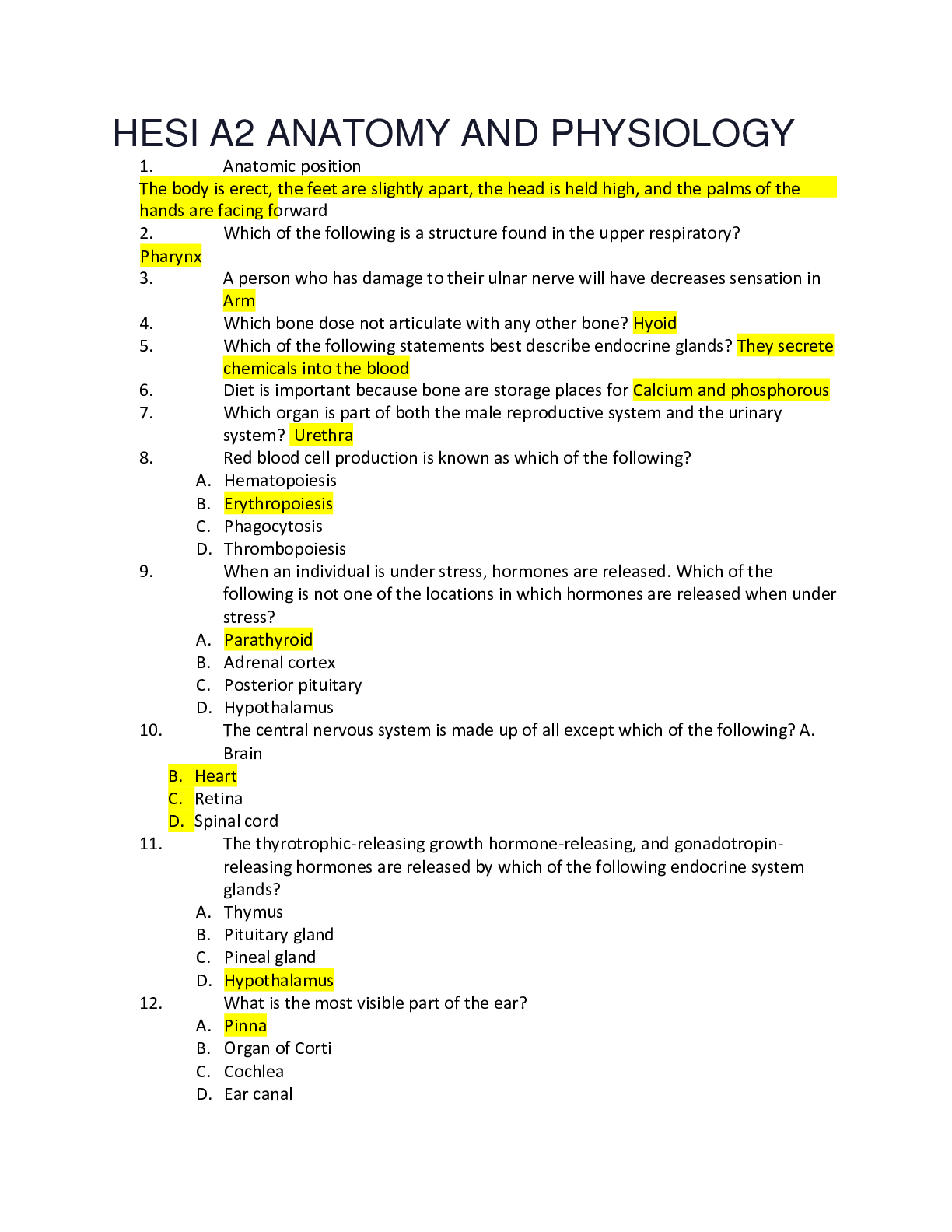



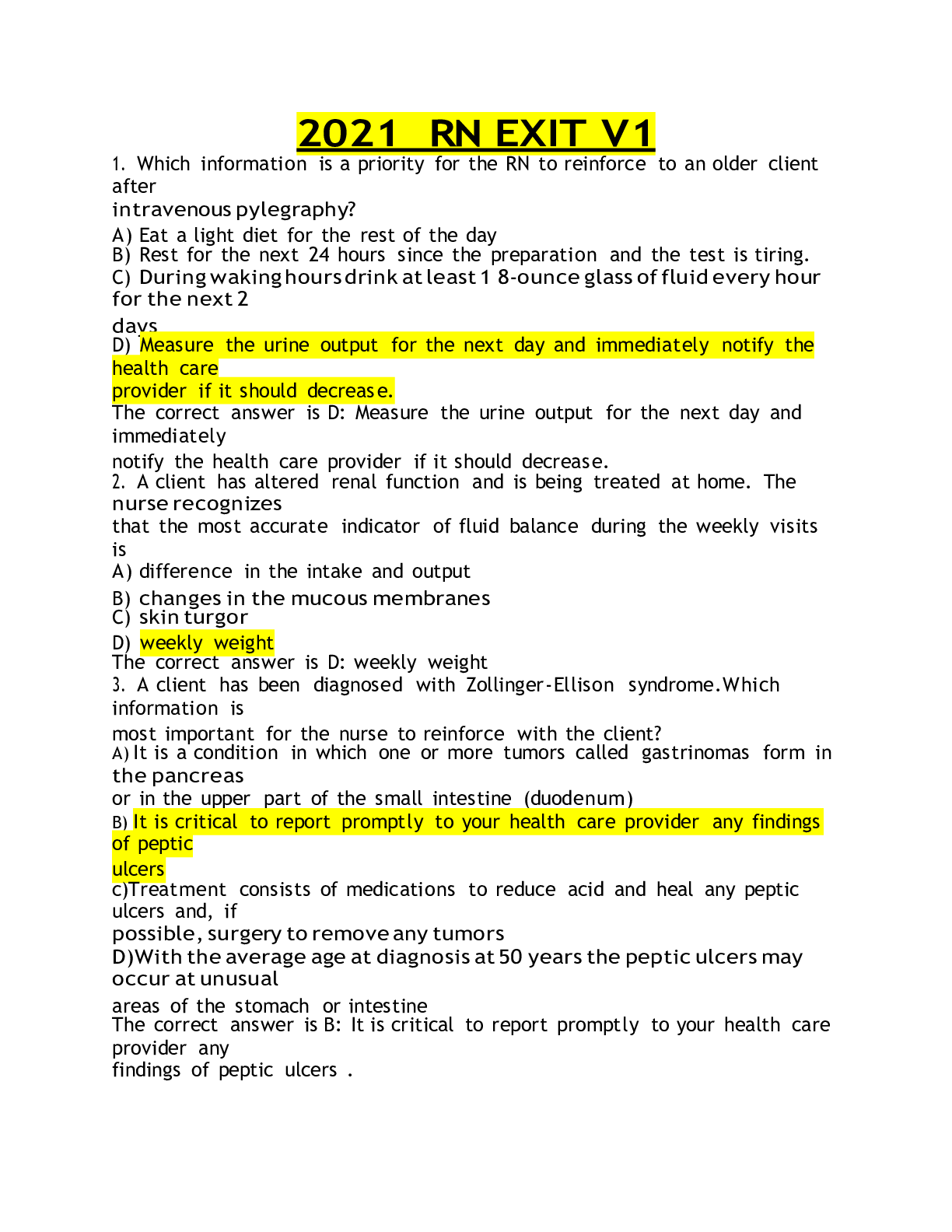
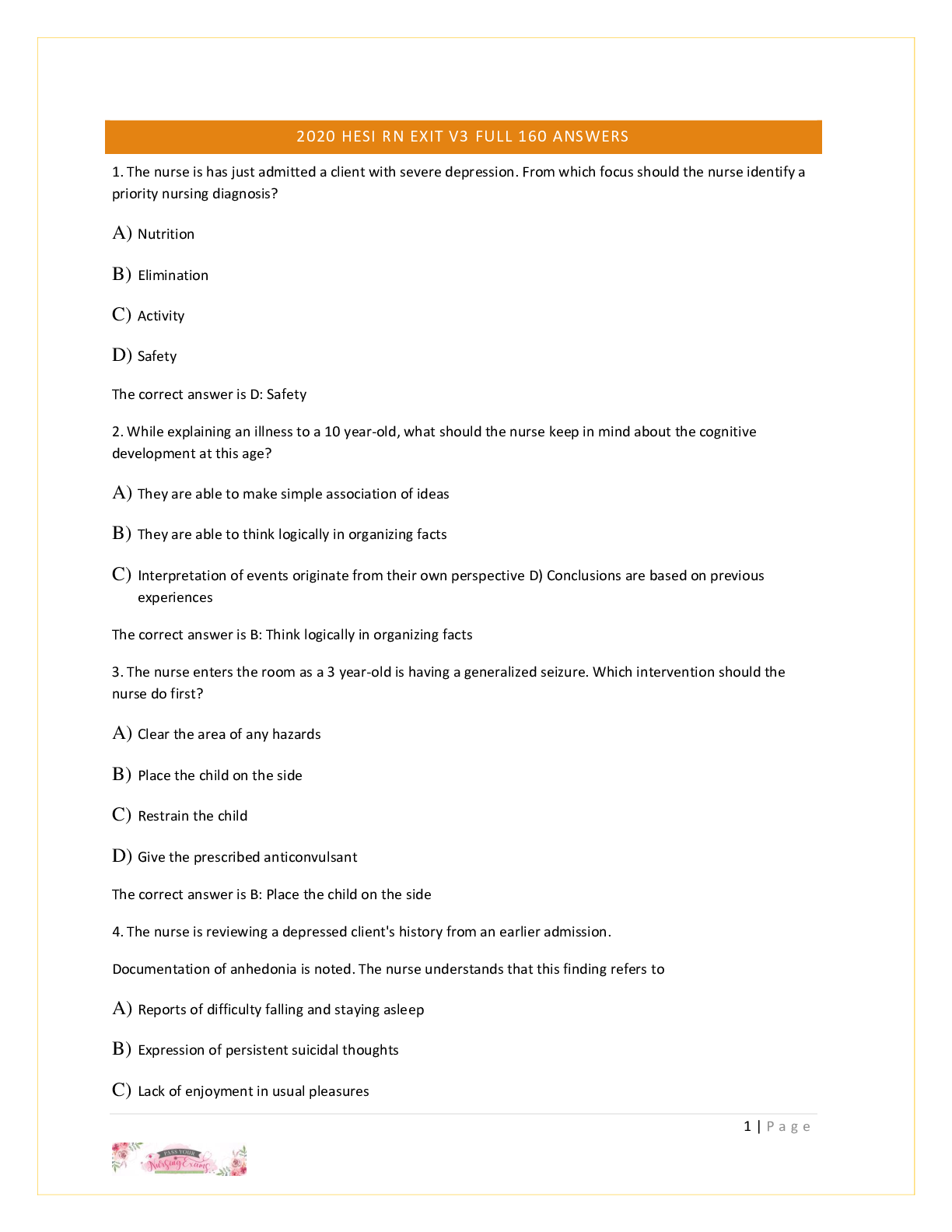
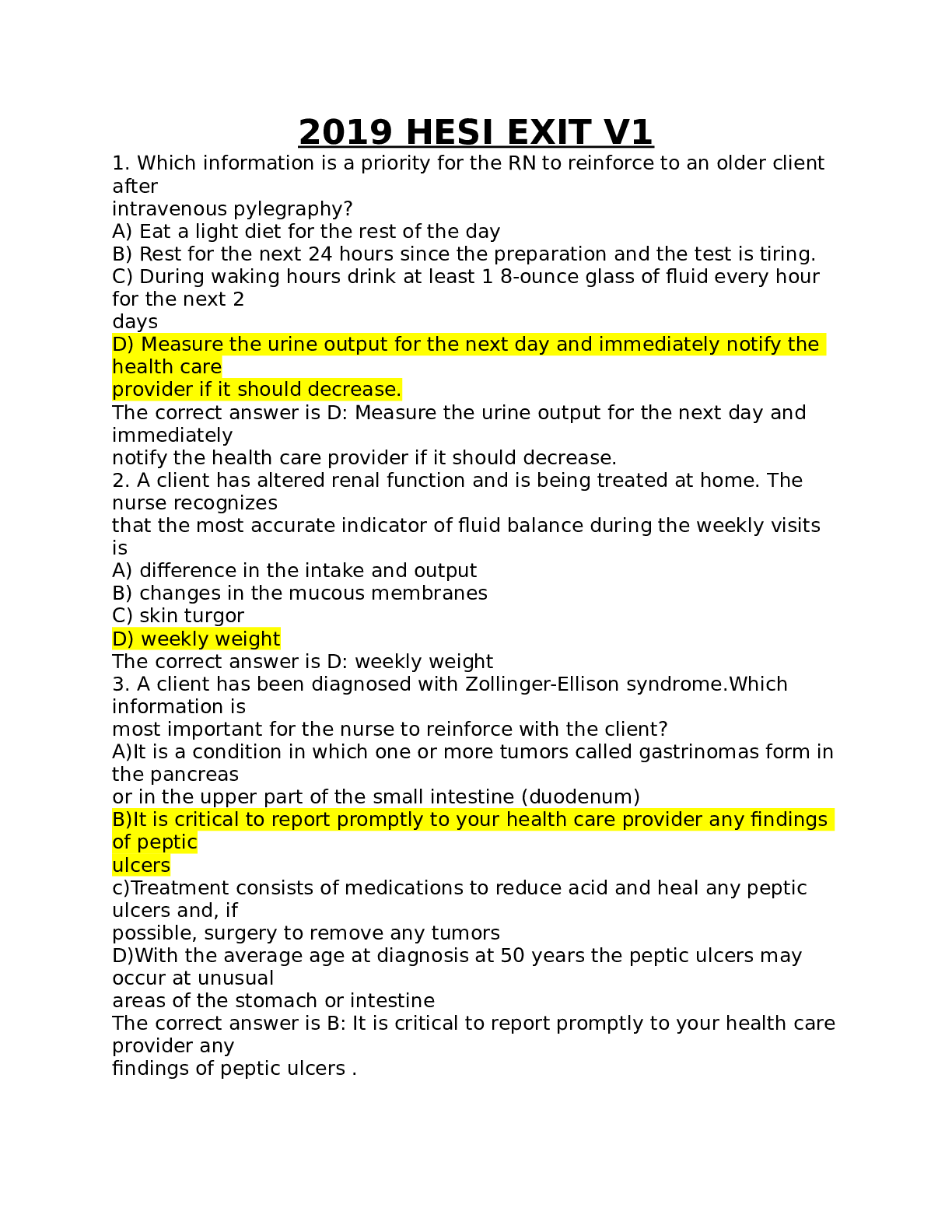



 Latest Questions and Complete Solutions.png)
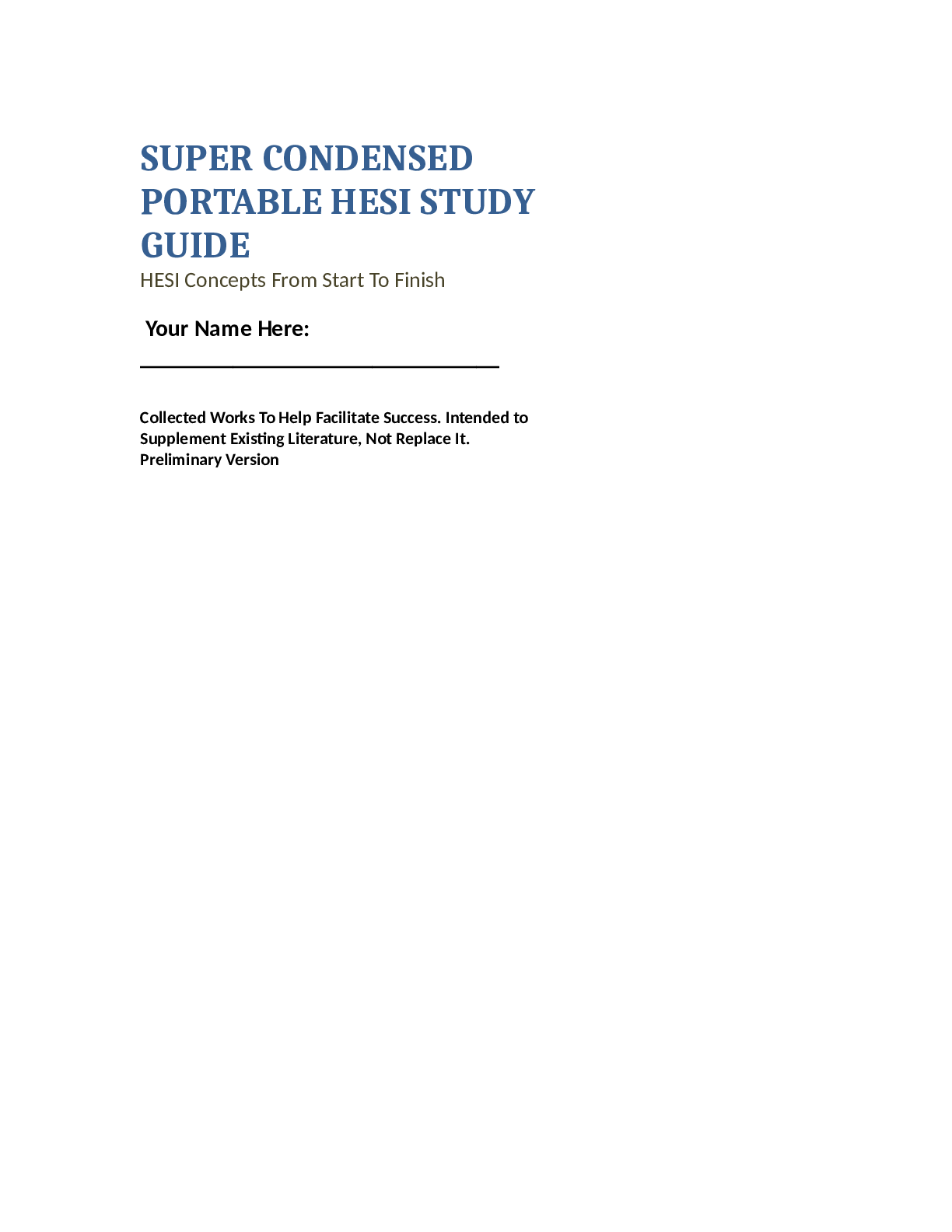




 (1).png)



